
Turjak Castle
Encyclopedia
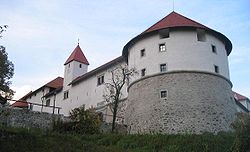
Castle
A castle is a type of fortified structure built in Europe and the Middle East during the Middle Ages by European nobility. Scholars debate the scope of the word castle, but usually consider it to be the private fortified residence of a lord or noble...
located above the settlement of Turjak
Turjak
Turjak is a settlement in the Velike Lašče municipality in central Slovenia. The entire municipality is part of the traditional region of Lower Carniola and is now included in the Central Slovenia statistical region....
, part of the municipality of Velike Lašče
Velike Lašce
Velike Lašče is a town and municipality in Slovenia. It is part of the traditional region of Lower Carniola and is now included in the Central Slovenia statistical region...
in the Lower Carniola
Lower Carniola
Lower Carniola was a kreis of the historical Habsburg crown land of Carniola from 1849 till 1919 and is nowadays a traditional region of Slovenia. Its center is Novo Mesto, while other urban centers include Kočevje, Grosuplje, Krško, Trebnje, Mirna, Črnomelj, Semič, and Metlika.-See also:* Upper...
region of Slovenia
Slovenia
Slovenia , officially the Republic of Slovenia , is a country in Central and Southeastern Europe touching the Alps and bordering the Mediterranean. Slovenia borders Italy to the west, Croatia to the south and east, Hungary to the northeast, and Austria to the north, and also has a small portion of...
. The castle is 20 km SE of Ljubljana
Ljubljana
Ljubljana is the capital of Slovenia and its largest city. It is the centre of the City Municipality of Ljubljana. It is located in the centre of the country in the Ljubljana Basin, and is a mid-sized city of some 270,000 inhabitants...
and is considered among of the most impressive in the area.
Etymology
The origin of the castle's name is uncertain: local tradition has held that it derives from the exctinct wild cattle aurochsAurochs
The aurochs , the ancestor of domestic cattle, were a type of large wild cattle which inhabited Europe, Asia and North Africa, but is now extinct; it survived in Europe until 1627....
(in Slovene, tur). It is likelier a corruption of the name of its founders, the knights Ursberg or Auersperg. The similarity to Turriaco
Turriaco
Turriaco is a town and comune in the province of Gorizia near the Isonzo river.Its name comes from the ancient latin name "Turris Aquae", the tower of the water....
in Italy
Italy
Italy , officially the Italian Republic languages]] under the European Charter for Regional or Minority Languages. In each of these, Italy's official name is as follows:;;;;;;;;), is a unitary parliamentary republic in South-Central Europe. To the north it borders France, Switzerland, Austria and...
, also known as Turjak in Slovene, is widely considered coincidental.
History
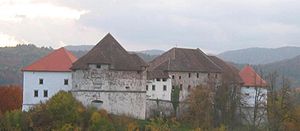
In 1190 it was rebuilt by count Adolf II von Auersperg, whose son Otto became entangled in a complicated war with the noble houses of von Gortz, Ortenburg, and the Patriarchate of Aquileia
Patriarchate of Aquileia (State)
The Patriarchate of Aquileia was an Imperial State in the Friulian region of Northeastern Italy under the control of the Patriarchs of Aquileia.- Foundation :...
, during which the castle was again flattened. Afterward, the site of the first two castles was abandoned in favor of the current one further upslope.
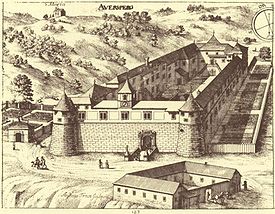
Holy Roman Empire
The Holy Roman Empire was a realm that existed from 962 to 1806 in Central Europe.It was ruled by the Holy Roman Emperor. Its character changed during the Middle Ages and the Early Modern period, when the power of the emperor gradually weakened in favour of the princes...
. In the 14th century, Auersperg owners included Gerhard (1317), and the brothers Friederich, Volkard and Herward. The castle was completely destroyed by the great earthquake of 1511, but was rebuilt in time to successfully resist a furious peasants' revolt in 1515 that laid waste to several other castles in the region. It faced a more serious challenge from Turkish raiders, who undertook major assaults against it in 1491 and 1528, but were repelled both times.
The Auerspergs had a reputation as capable military leaders; Ivan of Turjak fell in the battle of Vienna
Battle of Vienna
The Battle of Vienna took place on 11 and 12 September 1683 after Vienna had been besieged by the Ottoman Empire for two months...
in 1529, Herbard of Turjak
Herbard VIII von Auersperg
Herbard VIII von Auersperg, Freiherr from 1550, Slovene name: Hervard Turjaški was a governor of Carniola supporting Protestantism, and an imperial Habsburg general in the wars against the Ottoman Empire.-Life and career:Herbard von Auersperg was born into one of the oldest Austrian families...
(Herbard VIII von Auersperg) died at Budačko in 1575, while Andreas von Auersperg
Andreas von Auersperg
Andreas von Auersperg, Lord of Schönberg und Seisenberg was a Carniolan noble and leader of the defending forces at the Battle of Sisak in 1593....
, the "Carniolian Achilles," commanded Carinthian and Carniolan forces at the battle of Sisak
Battle of Sisak
The Battle of Sisak was fought on June 22, 1593, between Ottoman forces of the Bosnian governor-general, or Beylerbeyi, Hasan-paša Predojević, and forces of the Holy Roman Empire under the supreme command of the Styrian general Ruprecht von Eggenberg...
and contributed to a decisive victory against the Ottomans on 22 June 1593.
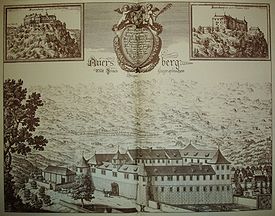
Protestant Reformation
The Protestant Reformation was a 16th-century split within Western Christianity initiated by Martin Luther, John Calvin and other early Protestants. The efforts of the self-described "reformers", who objected to the doctrines, rituals and ecclesiastical structure of the Roman Catholic Church, led...
in Slovenia. The major Slovene Protestant leaders Primož Trubar
Primož Trubar
Primož Trubar or Primož Truber was a Slovene Protestant reformer, the founder and the first superintendent of the Protestant Church of the Slovene Lands, a consolidator of the Slovene language and the author of the first Slovene-language printed book...
and Jurij Dalmatin
Jurij Dalmatin
Jurij Dalmatin was a Slovene Lutheran minister, writer and translator.Born in Krško in around 1546, Dalmatin became a preacher in Ljubljana in 1572. He was the author of several religious books, such as Karšanske lepe molitve , Ta kratki würtemberški katekizmus , and Agenda...
were offered sanctuary at the castle, and worked on the first translation of the Bible
Bible
The Bible refers to any one of the collections of the primary religious texts of Judaism and Christianity. There is no common version of the Bible, as the individual books , their contents and their order vary among denominations...
into Slovene during their stay. The Counts also offered financial support to the project of printing some of the first Slovene books.
17th century Turjak lords included Johan Andreas von Auersperg and Wolf Engelbert von Auersperg, the last noted by the historian Valvasor, who attested to the castle's importance by including two etchings of it in his "Glory of the Duchy of Carniola"
The Glory of the Duchy of Carniola
The Glory of the Duchy of Carniola is Johann Weikhard von Valvasor's most important work on history and natural history of his homeland Carniola, a central part of the present-day Slovenia and Istria in Croatia....
of 1689, including a two-page spread.
His son and successor Adam Anton Siegfried established a fideicommiss
Fee tail
At common law, fee tail or entail is an estate of inheritance in real property which cannot be sold, devised by will, or otherwise alienated by the owner, but which passes by operation of law to the owner's heirs upon his death...
or entailment in 1739 (the year of his death), including the Turjak lordship, the holding of Nadlischegg in Mokronog
Mokronog-Trebelno
Mokronog-Trebelno is a municipality in Slovenia. The municipality was created in 2006 when it seceded from the Trebnje municipality. It is part of the traditional province of Lower Carniola. The municipality is now included in the Southeast Slovenia statistical region.Tombs dating to the Early...
and the Turjak (or Auersperg) Palace in Ljubljana
Ljubljana
Ljubljana is the capital of Slovenia and its largest city. It is the centre of the City Municipality of Ljubljana. It is located in the centre of the country in the Ljubljana Basin, and is a mid-sized city of some 270,000 inhabitants...
. He was succeeded by eldest son Adolf Engelbert Ignaz, who died in 1768. On 20 May 1769, the allodial land ownership passed to his widow Elisabeth (nee Lichtenberg}, while the fideicommiss went to his brother-in-law Josef Maria.
After his death on 24 December 1805, the fideicommiss properties went to Johann Paul Alois, and then to the count Josef von Auersperg, who held it until his death on 12 October 1883, followed by his son count Leo von Auersperg. Between 1916 and 1931, the owner of the fideicommiss was Leo's son Herward, followed by his son, also named Herward.
On 19 September 1943, the castle was taken by partisans (ironically of the Prešeren brigade) after a lengthy battle with its garrison of White Guard
White Guard
The term White Guard may refer to:* White Guard , part of the White Army of the 1918 Finnish Civil War* White Guard , part of the Axis colaborators in Slovenia during the Second World War* Military arm of the Russian White movement...
Slovene Axis
Axis Powers
The Axis powers , also known as the Axis alliance, Axis nations, Axis countries, or just the Axis, was an alignment of great powers during the mid-20th century that fought World War II against the Allies. It began in 1936 with treaties of friendship between Germany and Italy and between Germany and...
auxiliaries. About five hundred of the latter were taken prisoner and became the target of retribution, in the form of notable war crimes. The castle was severely damaged in the battle, and lay in ruins for several years. Following WWII, the castle was nationalized, and restoration work slowly undertaken.
In 2006, the then-president of Slovenia
President of Slovenia
The function of President of the Republic of Slovenia was established on 23 December 1991, when the National Assembly of Slovenia passed a new constitution as a result of independence from Socialist Federal Republic of Yugoslavia....
, Janez Drnovšek
Janez Drnovšek
Janez Drnovšek was a Slovenian liberal politician, President of the Presidency of Yugoslavia , Prime Minister of Slovenia and President of Slovenia . He was born in Celje, Slovenia, then the Socialist Republic of Slovenia...
, founded the Movement for Justice and Development
Movement for Justice and Development
The Movement for Justice and Development is a Slovenian voluntary association founded in 2006 by the then president of Slovenia, Janez Drnovšek....
, a civil-society group, at a mass rally at the castle.
Architecture
The castle is of triangular layout and stands on a terraced hill. Large RenaissanceRenaissance
The Renaissance was a cultural movement that spanned roughly the 14th to the 17th century, beginning in Italy in the Late Middle Ages and later spreading to the rest of Europe. The term is also used more loosely to refer to the historical era, but since the changes of the Renaissance were not...
defensive towers (bastille
Bastille
The Bastille was a fortress in Paris, known formally as the Bastille Saint-Antoine. It played an important role in the internal conflicts of France and for most of its history was used as a state prison by the kings of France. The Bastille was built in response to the English threat to the city of...
s) at the points of the triangle are connected by residential wings. The western tower contains a suite of dungeons of varying degrees of unpleasantness. The tall central palacium dates from the Romantic period.
The castle has been significantly altered several times throughout its history. As recently as the 1680s, the Valvasor engravings show a rectangular structure with small towers at only two corners and a large bastille at the eastern end. This layout dates to the major rebuilding after the devastating 1512 earthquake, though some pre-16th century elements survive, notably the north wing and portions of the defensive walls.
The original 10th or 11th century castle stood lower on the slope; some minor ruins are still visible.
The castle is unusual in having two chapels. A Catholic
Catholic
The word catholic comes from the Greek phrase , meaning "on the whole," "according to the whole" or "in general", and is a combination of the Greek words meaning "about" and meaning "whole"...
one on the west side has served as a church since 1789; after a 1990 renovation, mass has been held there every Sunday. A second Romanesque Protestant chapel is named after Dalmatin, and contains the tombs of the Protestant counts, as well as gothic frescoes.
Cultural significance
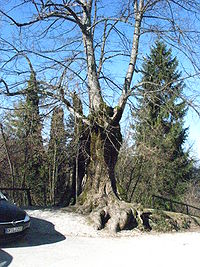
- Once displayed in the castle armory were the heads of Herbard von Auersperg and Friedrich von Weichselburg (Slovene: Herbard Turjaški and Friderik of Višnja GoraVišnja GoraVišnja Gora is a settlement in the Ivančna Gorica municipality in central Slovenia. It is one of the best-preserved medieval towns in Slovenia. The area is part of the historical region of Lower Carniola...
), both killed in battle with OttomanOttoman EmpireThe Ottoman EmpireIt was usually referred to as the "Ottoman Empire", the "Turkish Empire", the "Ottoman Caliphate" or more commonly "Turkey" by its contemporaries...
forces in 1575. Their heads were skinned and tanned, then sent as mementos to the Sultan in ConstantinopleConstantinopleConstantinople was the capital of the Roman, Eastern Roman, Byzantine, Latin, and Ottoman Empires. Throughout most of the Middle Ages, Constantinople was Europe's largest and wealthiest city.-Names:...
, from where relatives later ransomed them at considerable cost.
- The chapel of the Turjak graveyard houses a glass jar containing the preserved heart of the young count Hanno von Auersperg (1838-1861), who supposedly committed suicide after being exiled to NaplesNaplesNaples is a city in Southern Italy, situated on the country's west coast by the Gulf of Naples. Lying between two notable volcanic regions, Mount Vesuvius and the Phlegraean Fields, it is the capital of the region of Campania and of the province of Naples...
by his family for refusing to give up a girl who was beneath him socially.
The castle is also known for its importance to the history of the Reformation in Slovene lands; its greatest claim to fame, however, is as the setting of one of Slovene national poet France Prešeren
France Prešeren
France Prešeren was a Slovene Romantic poet. He is considered the Slovene national poet. Although he was not a particularly prolific author, he inspired virtually all Slovene literature thereafter....
's most popular ballads, "Rosamund of Turjak" (Turjaška Rozamunda). It concerns the wooing of the bratty heiress of Turjak in the late Middle Ages, and begins:
- An oak there stands in the court of Turjak,
- lifts its top into the clouds,
- in its shade by a stone table,
- an assembly sits of noble gentry,
- for the Lord of Turjak hosts again
- the suitors of Rosamund.
- ...
Sources
- Turjak, burger.si
- Grad Turjak, arnes.si
- http://darja-skrlj.figure-skating-corner.com/turjak_slo.htm Darja Skrlj
- http://www.lok-klub-turjak.si/grad/grad.html Ground plan of Turjak Castle
- http://web.archive.org/web/20091026233728/http://geocities.com/turjakcastle/
- http://www2.arnes.si/~azabuk/Eks240902/grad_turjak.htm
- http://web.archive.org/web/20091026221322/http://geocities.com/jamnikjanez/turjak.htm

